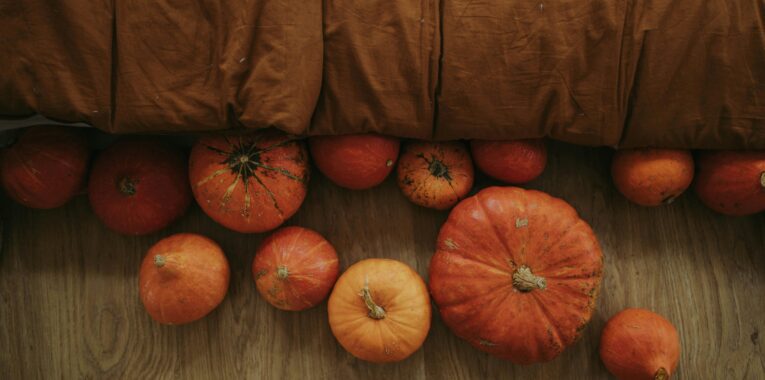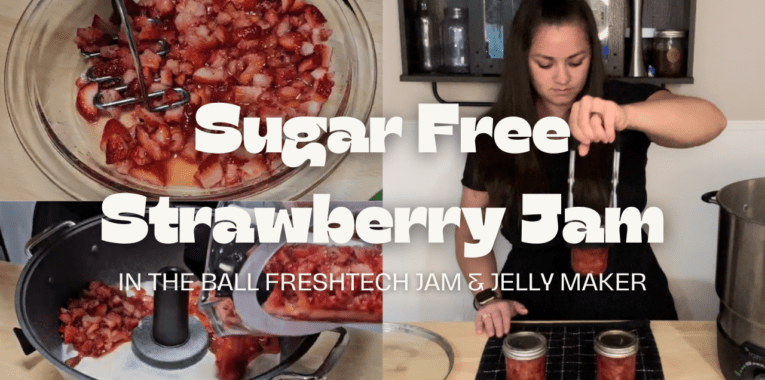It’s June and, before preserving season is in full swing with produce coming in from the garden, it’s time to take care of any pumpkins and winter squash left over from last year’s harvest! The National Center for Home Food Preservation does not recommend canning pumpkin puree because of potential density issues, so how else can we preserve pumpkin? By dehydrating and freezing it!
As an Amazon Affiliate, I earn from qualifying purchases.
Dehydrating Pumpkin Puree
Dehydrating pumpkin puree is my favorite way to preserve it because I use it to make my Pumpkin Bars In a Jar and because it rehydrates just like canned puree! It’s also a great way to save your freezer space for other things.
All you need to dehydrate pumpkin puree is an oven, an immersion blender (or regular blender or food processor), a dehydrator, and a food processor! I use a 6-tray Cosori dehydrator and absolutely love it!
Here’s a quick run-through of the dehydrating process! First, bake the pumpkin until cooked through. Then, puree the pumpkin with a blender or immersion blender and cook down until you reach your desired consistency. Then, spread on fruit leather sheets and dehydrate at 125 degrees Fahrenheit in a dehydrator for 10-12 hours. To tell if the pumpkin is properly dehydrated, bend a corner of the pumpkin sheet. If it breaks, it’s finished. If it does not break, continue dehydrating until it is completely dehydrated. Using a food processor, process the pumpkin until it is a powder or very small pieces. Store in a mason jar.
Freezing Pumpkin Puree
This is the fastest and easiest way to preserve pumpkin puree. All you need to freeze puree is an oven, an immersion blender (or regular blender or food processor), and a freezer!
I also recommend these stands that hold reusable or disposable freezer bags open so you can fill them more easily.
Rehydrating Pumpkin Puree
To rehydrate pumpkin puree, the water-to-pumpkin ratio is 4:1. So, if you want about one cup of pumpkin puree, you would combine 1 cup of water and 1/4 cup of pumpkin puree powder. You can add more water if you want a thinner consistency or less water if you want a thicker consistency.
Pureeing Pumpkin Instructions
- Preheat oven to 375 degrees Fahrenheit.
- While oven is preheating, cut pumpkin in half and scoop out seeds.
- Cut pumpkin into pieces that will fit on your baking tray(s).
- Put pumpkin onto trays with skin-side up and put trays into oven.
- Bake for 45 minutes or until pumpkin is tender.
- Remove from oven and let cool until it is cool enough to touch.
- If there is any water in the baking trays, drain it off.
- Remove skin from pumpkin. It should peel off, but, if it doesn’t, you can use a spoon or a knife to separate the skin from the pumpkin flesh.
- Add baked and peeled pumpkin to a large bowl or stock pot.
- Using an immersion blender, blender, or food processor, blend pumpkin until it is the consistency of pumpkin puree.
- If you would like the pumpkin puree to be thicker, cook it over medium high heat, stirring constantly, until it reaches your desired consistency.
Dehydrating Pumpkin Puree Instructions
- Fill fruit leather trays that fit your dehydrator with pumpkin puree.
- Make sure the pumpkin puree is spread evenly on the trays.
- Dehydrate at 125 degrees Fahrenheit for 10-12 hours.
- After 10-12 hours, check the pumpkin puree for dryness.
- If the dehydrated puree doesn’t snap when it is broken, put the trays back in and continue dehydrating at 125 degrees Fahrenheit for 2-hour periods until completely dehydrated.
- Once the puree is completely dehydrated, break it into smaller pieces that will fit in your food processor.
- Process until the puree turns into a powder or smaller pieces.
- Store puree in a mason jar, turning every day for 5-7 days to ensure there are no clumps of pumpkin puree.
- If your puree is clumping, it’s a sign that the pumpkin puree might not have dehydrated completely. Spread the puree pieces on a dehydrating tray and dehydrate again until completely dehydrated.
- In a 4:1 ratio, combine warm water and pumpkin puree powder. For example, if you want to rehydrate 1 cup of pumpkin puree, add 1 cup of water to 1/4 cup pumpkin puree powder.
- Use as you would use pumpkin puree.
Powdering Pumpkin Puree Instructions
Rehydrating Pumpkin Puree Powder Instructions
Freezing Pumpkin Puree Instructions
- Label reusable or disposable freezer bags with the name of what you’re freezing and the date you’re freezing it.
- Put the desired amount of pumpkin puree into reusable or disposable freezer bags.
- Flatten out, ensuring as much air as possible is pushed out of the freezer bag.
- Freeze until ready to use.

